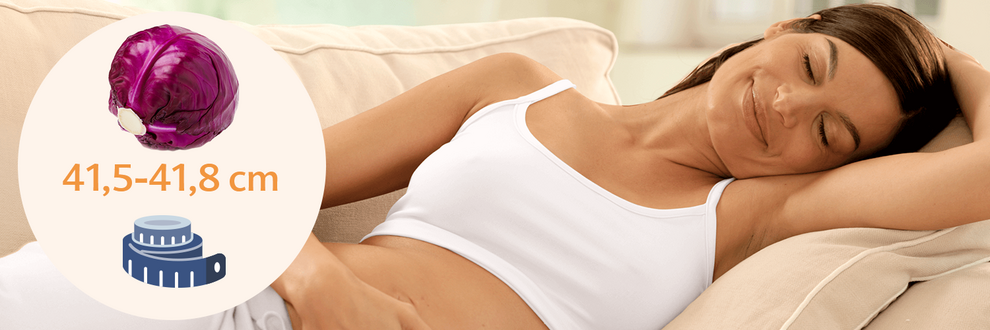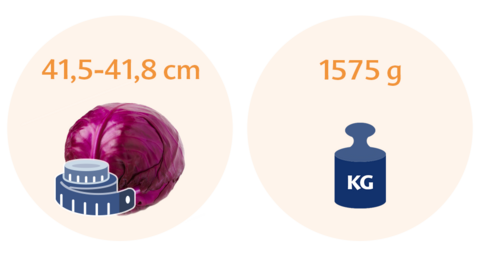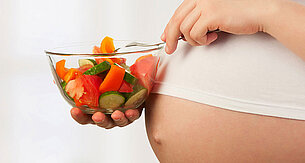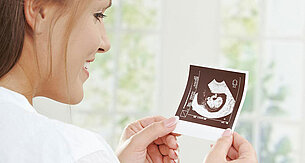Pregnancy weeks:
Week 31 of your pregnancy: Now’s the time to start planning for your baby’s birth

Week 31 has begun, and the tension and excitement are building – it’ll soon be time to give birth to your child. In around ten weeks’ time, you will finally be able to hold them in your arms for the first time. You’ll already have formed a close bond with your baby, so do what you can to help your partner form a similar bond as you prepare to meet the newest member of your family.
Size of your baby in week 31

By now, almost at the end of the eighth month of your pregnancy, your baby has grown to the considerable size of 41.5-41.8 cm (if you can picture a red cabbage, about that big), though they’re not yet as big as they will be at birth. They weigh 1575 grams, so they’re gradually approaching two kilograms, and they’ll continue to put on their baby fat and gain weight until they’re born. Depending on their genes, their weight can almost double between now and the birth.
Your baby’s development
Lung development
While your baby is putting on weight and getting bigger, their internal organs are completing their development and beginning to do their jobs. From week 31, your baby can fully expand their lungs without the alveoli sticking to each other thanks to the protective protein surfactant. Interesting fact: their lungs are so sufficiently developed that, if they were born premature now, they would merely need assistance with breathing rather than full mechanical ventilation.
Moving into position
Your baby will be moving a lot less in week 31, partly because there isn’t enough space in the womb and partly because they’ve settled into a clear sleeping and waking pattern which can involve sleeping for over 15 hours a day. You’ll feel their activity vividly when they’re awake, and their prods, punches and kicks to your organs can be extremely forceful and cause minor symptoms.
They haven’t yet moved into the position they’ll need to be in for birth. However, they’ll gradually lie against the wall of your uterus, and their head will begin to move to where it’ll be when the time comes to leave the womb via the birth canal.
The right position for birth, known as the cephalic or occiput anterior position, is with their head down towards the cervix, and they should be in this position by the time labour begins. Your doctor will regularly check their position from now on. 90 per cent of babies move into this position by themselves around four weeks before the birth.
What it’s like for the mum-to-be in week 31
You may well feel a little overwhelmed at times when you look ahead to what you’re about to go through. One thing you’ll be thinking about a lot is where you’re going to give birth: you’ll want answers to questions about how safe it is for you and your baby as they come into the world. If you haven’t done so already, we recommend that you visit a few delivery units and joining their maternity tour.
Common signs and symptoms
Your thoughts revolve around your baby
In week 31, you’ll be thinking more and more about the things you’ll need to get for your baby – and that may involve welling up at cute little babygros, jumpers, cardigans and shoes. Your friends and family are bound to have some things they can pass on to you, so it’s a good idea to create a wish list and send it out, whether online or the old-fashioned way. Don't forget to buy things for yourself for when it’s time to give birth: you’ll soon be packing a bag to have with you during your hospital stay. It will contain the clothes (including baby clothes), toiletries, towels, etc., that you’ll need after giving birth. Find out more about what a newborn baby needs.
Your body goes on strike
Sometimes it’ll feel like your body has gone on strike. Your lungs groan under the load from your belly, your legs get heavy and sore and your back is tense. You’ll often be kept awake at night and will be tossing and turning in bed, trying to find a comfortable position that allows you to sleep – and as if that weren’t enough, your frequent need to pee will mean you don’t get many peaceful nights at all. There’s a higher chance you’ll get heartburn after meals, although you can minimise this by eating smaller meals spread across the day rather than larger ones at the usual times (this will also benefit your intestine, which is struggling as its usual rhythm has been disrupted by the pressure from your womb). You’ll also find it increasingly difficult to sit down and stand up, and will instinctively hold onto your belly and back to support yourself in the process. Before too long, your partner will have to tie your shoes for you or you’ll have to start wearing slip-ons.
Incontinence
The pressure on your pelvic floor, and your baby’s head pressing against your bladder, means that your bladder muscles no longer hold in liquid as reliably as before. As a result, you might wet yourself a little when you laugh, sneeze or cough, especially when your bladder is full. This is common in the latter stages of pregnancy, and it will get better after the birth. You can accelerate that process by training your pelvic floor during postnatal gymnastics courses.
Your belly button becomes an outie
In week 31, your womb and the skin on your belly have grown and stretched so much that your belly button first flattens, and then may even become an outie before too long. This will be clearly visible if you’re wearing fewer layers.
Questions you may want to ask your doctor
Freezing stem cells and umbilical cord blood
As parents-to-be, you may have the option of deciding what you want to do with the placenta. The hospital can dispose of it for you, or they can give it to you after the birth to take home – more and more parents are using the placenta to plant a “baby tree” or to make beads.
Alternatively, you can take cells from the placenta and freeze them to serve as your baby’s own stem cells if they suffer from a disease.
The same applies to the blood in the umbilical cord, which also contains your baby’s own stem cells which can be frozen and used to help in case of disease.
Seek advice from your doctor or (even better) a paediatrician, and get quotes from companies specialising in placenta stem cell storage if you’re interested in pursuing this option – and make sure it’s a reputable company that you can trust, as this is about your family’s stem cells.



